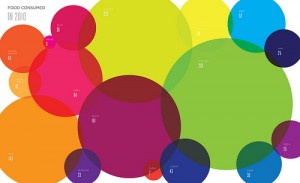Why Every Web Designer Should Master Infographics
 We’re living in a day and age that is finding people evolving to great extents as far as how they process information. As a result, their expectations in regards to what they expect from their information sources is evolving as well. People are responding to information sources that pack more of a visual punch, meaning they’re less willing to plow through lots of text with each passing day. They are also busier, less patient, and more eager to get to the point than ever before.
We’re living in a day and age that is finding people evolving to great extents as far as how they process information. As a result, their expectations in regards to what they expect from their information sources is evolving as well. People are responding to information sources that pack more of a visual punch, meaning they’re less willing to plow through lots of text with each passing day. They are also busier, less patient, and more eager to get to the point than ever before.
All that said, it’s no surprise that a web design interface like infographics is becoming such a hot trend in web design. Infographics are those nifty little combo deals that so efficiently combine pictures and information. They utilize the visual appeal of a streamlined, coherent graphic design to teach, inform, or help a web viewer in regards to a given concept and the masses at large are responding to them in a big way. Here’s a closer look at what they bring to the table and why every graphic and web designer needs to master them.
Infographics Help Make Complicated Concepts Simple
You know what they say – “a picture is worth a thousand words”. Well, infographics have proved that statement right and then some. Well-crafted infographics help break information, steps, and directions down in a way that is universally easy to understand. They help convey information via multiple avenues and this method has actually been proven to help people learn or grasp a given concept with ease.
Since infographics appeal to both picture-based and text-oriented learners, they represent a failsafe way to get a point across. As a web designer, you would do well to learn the ins and outs of making effective ones for this reason.
Infographics Are Easy (and Fun) to Share
With social networking platforms such as Pinterest, Tumblr, Facebook, Twitter, and Google Plus on the rise to an increasing degree every day, it pays to present valuable information via easily shareable formats. Regurgitating an idea you read takes time and effort most people don’t want to invest in their average media-sharing post. Even the sharing of article links is on the decline. People these days are interested in sharing pictures and images like infographics. Just look at any active Tumblr or Facebook account and you’ll see tons of them!
The easier and more fun information is for your visitors to share, the more likely they are to pay attention to it and pass it on to others. In fact, the marketing and SEO campaigns of the future are expected to try to leverage this phenomenon to an increasingly great degree in the years to come. Thorough web designers should think about adding infographics to their standard service portfolio now for that reason.
Infographics Are Professional
Sleek graphics that include charts, graphs, and other such elements help a given website or business bolster their professional reputation. They also add a great deal of visual interest to a landing page, website, blog, or social networking profile. Major companies and corporations have been using infographics to relay information and provide visual aids for decades. Now that the concept has hit the mainstream, the professional connotations attached to such images remain.
However, it’s important to understand that as is the case with any other type of design, an infographics can either be stellar and make a great impression… or it can be shoddy and off, actually hurting the impression made by the company it’s attached to. Learning how to produce professional, dynamic infographics for a wide range of website owners and business personnel can make a huge difference in where you as the designer can expect to go next professionally speaking.
Matt Dandurand is the CEO of MediaContour.com, offering web design in Los Angeles, CA.
Image Credit: 1.


Yeah, I agree. Having a lot of infographics is useful, particularly when you want to display a lot of information and statistics in an interesting manner.
Most of us are visuals, I mean most of us prefer videos or pictures rather than reading or listening. And it makes every complicated things simple, just to be sure that you are making it simple as you can.